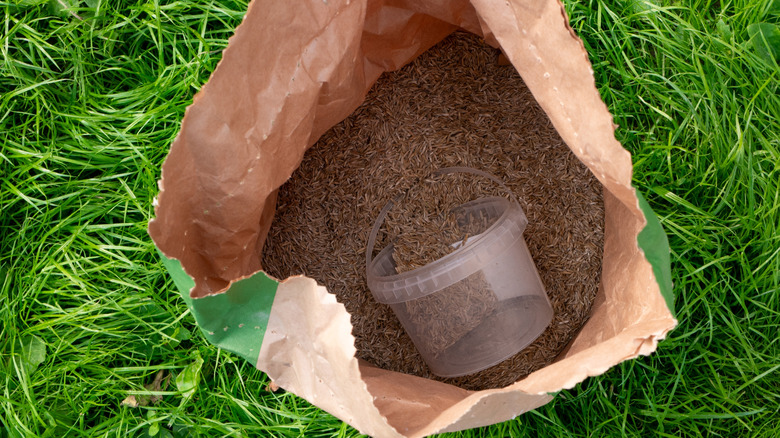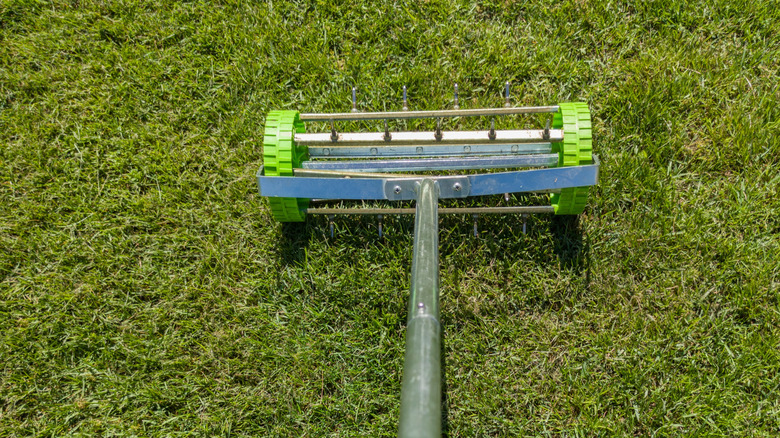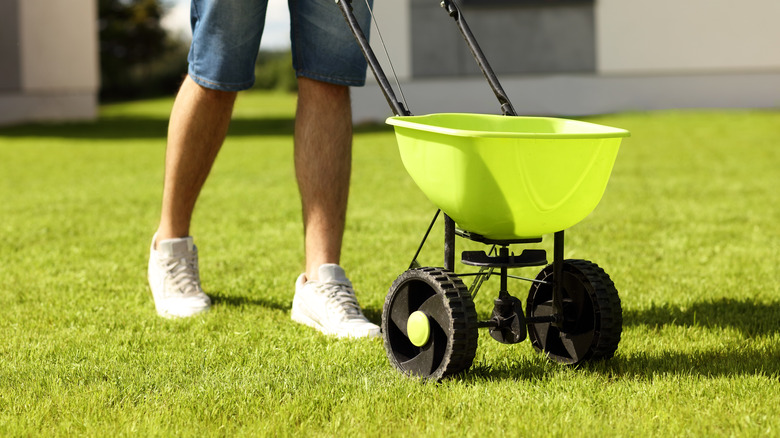The Very Best Way To Overseed Your Lawn
We may receive a commission on purchases made from links.
A beautiful, lush lawn doesn't just happen by accident; it requires some strategic planning and effort to keep your grass at a good thickness. If you start finding thinning areas or brown spots, you may want to consider overseeding. The best time of year to overseed your lawn really depends on the type of grass you have. Cool-season grasses, like Kentucky bluegrass or fescue, will benefit most from overseeding during the fall. Warm-season varieties, like Bermuda or zoysia, should be overseeded in late spring. So, before planning anything out, take some time and assess your lawn's condition. Look for any areas of compacted soil, thatch buildup, or spots where water collects, which indicate poor drainage. These problem areas should be addressed as they can ruin new seed germination before it even gets a chance to start.
Once you're ready to overseed, you'll want a few tools to help make the process smoother. A core aerator is needed to help tackle any soil compaction. For smaller lawns, a manual aerator will work just fine, but if you have a large lawn, you may want to rent a powered model. You'll also want a quality rake to help loosen the soil before seeding, or to take care of any thatch problems. A broadcast spreader, like this Scotts Turf Builder EdgeGuard Mini Broadcast Spreader, will help distribute your new seed as evenly as possible, and a lawn roller will press the laid seed into the soil without pushing it in too deeply. You can certainly accomplish overseeding without any of these tools, but they will make the job simpler and help provide much better results in the long run.
Selecting the right seed and preparing your lawn
It may seem obvious, but it's very important always to match the new seed to your existing lawn type. Mixing incompatible grasses will lead to patchy and uneven growth, so make sure you know exactly what your lawn is already made up of. Take a look at the landscape of your lawn as well. If you have very few shade spots, you'll want to stick with drought-resistant varieties like tall fescue or perennial ryegrass. If your yard is littered with trees and shade, St. Augustine or zoysia grass will perform much better. Always look for certified seed blends with low weed content and high germination rates. Also, consider coated seeds, which help retain moisture and resist birds better.
The first crucial step in overseeding your lawn is preparing it for the seed. You'll want to begin by giving your yard a good mowing. Try mowing it a little shorter than usual, leaving about 1.5 to 2 inches. This helps the sunlight reach new seeds and gives the whole process a good start. Remove any clippings or debris around that may smother the seeds. Aerating the lawn is next; the holes created allow seeds, water, and nutrients to penetrate deeper into the soil. If your lawn is thick with thatch, take time to dethatch with a specialized rake or machine so that your new seed gets to sit on the soil itself, rather than on a chunk of dead organic material. If you have problem areas with poor soil, a thin layer of topsoil or compost will help provide extra nutrients to the newly spread seed. Also, avoid chemical weed killers before or after overseeding, as the chemicals can prevent germination in new seed.
The overseeding process and essential aftercare
The actual overseeding process is fairly simple. Start by evenly spreading half the seed in any one direction, then the other half in a perpendicular direction, much like how you would mow your lawn. This helps make sure you get every area covered. A broadcast spreader works best for large lawns, but a hand spreader can work just fine in smaller areas. After seeding, lightly rake the area to work the seeds into the soil, or use a lawn roller to push them down gently. Try not to go more than a quarter-inch to a half-inch deep. Once finished, apply a suitable starter fertilizer that's high in phosphorus to promote strong root development without burning young grass.
After you've seeded the lawn, post-care is essential. Water consistently for the first two weeks to keep the soil moist but not soggy. This may require a light watering two to three times a day. As the seedlings grow, you'll be able to reduce the frequency, but you'll want to use more water to encourage deeper roots. Stick to a morning routine as it's the best time to water your lawn. Avoid mowing the new grass until it reaches around 3 inches tall, and even then, make sure your mower blades are sharp to prevent any uprooting. If you start seeing bare spots after a month or so, a second light seeding may be necessary. In the end, with some proper planning and care, your lawn will fill in thicker and healthier, increasing the curb appeal of your home.


